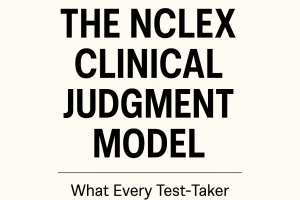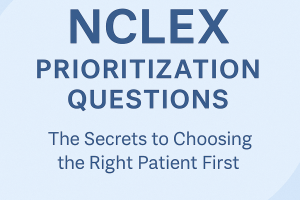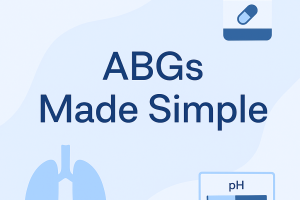Critical Care Concepts: What to Expect on the NCLEX

Introduction:
Critical care nursing represents one of the most challenging and rewarding aspects of healthcare. For those preparing for the NCLEX-RN, understanding critical care concepts is essential. The exam tests not only your theoretical knowledge but also your ability to think critically and apply clinical judgment in high-pressure situations.
From managing acute conditions to prioritizing care in life-threatening scenarios, critical care concepts are a central focus of the NCLEX-RN. In this blog, we will explore key critical care topics you should master, how they are tested on the NCLEX, and strategies to help you succeed.
1. Why Critical Care Concepts Matter on the NCLEX
Critical care nursing involves managing patients with life-threatening illnesses or injuries. The NCLEX ensures that candidates are equipped to handle these high-stakes scenarios safely and effectively. Topics related to critical care fall under several test plan categories, including:
• Management of Care: Delegation, prioritization, and interprofessional collaboration.
• Safety and Infection Control: Preventing harm to patients in critical care settings.
• Physiological Adaptation: Responding to and managing acute changes in patient conditions.
Mastery of these concepts ensures that you’re prepared to deliver high-quality care in situations where every second counts.
2. Key Critical Care Concepts to Know
1. Prioritization of Care
Understanding how to prioritize interventions is crucial for critical care scenarios. The NCLEX often uses frameworks like:
• ABCs: Airway, Breathing, Circulation.
• Maslow’s Hierarchy of Needs: Addressing physiological needs before psychological or social concerns.
Example: If a patient has multiple issues, such as low oxygen saturation and anxiety, the NCLEX will test whether you prioritize oxygenation over addressing their emotional state.
2. Recognizing Signs of Acute Deterioration
Critical care requires quick recognition of symptoms indicating patient decline. The NCLEX may test your ability to identify and respond to:
• Shock states (e.g., hypovolemic, septic, or cardiogenic shock).
• Respiratory distress or failure.
• Cardiac emergencies such as myocardial infarction or arrhythmias.
3. Advanced Life Support
While the NCLEX doesn’t require memorizing all ACLS algorithms, understanding the basics of resuscitation and post-resuscitation care is essential. For example:
• Identifying when to initiate CPR.
• Recognizing rhythms like ventricular fibrillation or asystole.
• Administering emergency medications such as epinephrine.
4. Hemodynamic Monitoring and Interventions
The exam may include questions about interpreting hemodynamic parameters like:
• Blood pressure, central venous pressure (CVP), and mean arterial pressure (MAP).
• Understanding the use of devices like arterial lines or pulmonary artery catheters.
5. Infection Control in Critical Care
Preventing healthcare-associated infections (HAIs) is a critical competency. Expect questions about:
• Central line-associated bloodstream infections (CLABSIs).
• Ventilator-associated pneumonia (VAP).
• Sepsis identification and management.
3. How Critical Care Concepts Are Tested on the NCLEX
The NCLEX uses multiple formats to assess critical care knowledge, including:
• Multiple-choice questions: Straightforward scenarios requiring prioritization or recognition of symptoms.
• Select All That Apply (SATA): Testing your ability to choose multiple correct interventions.
• Case studies: These evaluate your ability to apply critical thinking to complex, multi-layered scenarios.
Example:
A question may describe a patient with increasing respiratory distress. You may be asked to:
1. Prioritize interventions.
2. Interpret ABG results.
3. Choose appropriate nursing actions.
4. Tips for Mastering Critical Care Concepts on the NCLEX
1. Use Mnemonics
Critical care topics often involve detailed information. Mnemonics like “MONA” (Morphine, Oxygen, Nitrates, Aspirin) for managing acute coronary syndrome can help you recall key steps.
2. Practice NCLEX-Style Questions
The more questions you answer, the better you’ll understand how critical care concepts are presented. Focus on practice tests that emphasize prioritization and clinical judgment.
3. Focus on the Test Plan
Review the NCLEX test plan, which outlines content areas and their weight on the exam. Allocate more time to high-priority topics.
4. Stay Calm Under Pressure
Simulating high-stress test scenarios will prepare you to think clearly during the exam. Practice timed question sets to build your confidence.
5. Practice Questions
Question 1:
A 68-year-old patient presents with confusion, weak pulse, and cold, clammy skin. What should the nurse do first?
a. Administer intravenous fluids.
b. Check blood glucose levels.
c. Apply oxygen via nasal cannula.
d. Obtain an EKG.
Answer: c. Apply oxygen via nasal cannula.
Rationale: Airway and oxygenation take priority in this scenario, following the ABC framework.
Question 2:
Which signs indicate septic shock in a critically ill patient? Select all that apply.
a. Hypotension despite fluid resuscitation.
b. Bradycardia.
c. Increased serum lactate levels.
d. Decreased urine output.
e. Warm, flushed skin.
Answer: a, c, d, e.
Rationale: Septic shock presents with hypotension, high lactate levels, reduced urine output, and early warm skin (due to vasodilation).
Question 3:
A patient on mechanical ventilation has a sudden drop in oxygen saturation and absent breath sounds on one side. What should the nurse suspect?
a. Pulmonary embolism.
b. Tension pneumothorax.
c. Acute respiratory distress syndrome (ARDS).
d. Bronchospasm.
Answer: b. Tension pneumothorax.
Rationale: Sudden oxygen desaturation with absent breath sounds indicates a possible pneumothorax, a critical care emergency.
Question 4:
What is the nurse’s priority intervention for a patient with ventricular fibrillation?
a. Administer epinephrine.
b. Defibrillate immediately.
c. Perform synchronized cardioversion.
d. Administer amiodarone.
Answer: b. Defibrillate immediately.
Rationale: Defibrillation is the definitive treatment for ventricular fibrillation to restore normal rhythm.
Question 5:
Which lab value requires immediate intervention in a patient receiving heparin therapy?
a. Platelet count of 200,000/mm³.
b. aPTT of 50 seconds.
c. Hemoglobin of 14 g/dL.
d. Platelet count of 75,000/mm³.
Answer: d. Platelet count of 75,000/mm³.
Rationale: A low platelet count may indicate heparin-induced thrombocytopenia, a critical condition requiring immediate action.
Conclusion:
Critical care concepts on the NCLEX test not only your knowledge but also your ability to prioritize, think critically, and act decisively. By understanding the key areas of focus and preparing strategically, you can confidently tackle these challenging questions. Remember, the goal is to ensure patient safety and effective care in high-stakes scenarios—a skillset that will serve you well in your nursing career.
Final Tip: Practice, review, and stay confident. You’ve got this!






